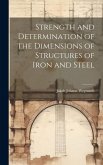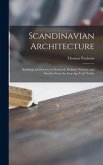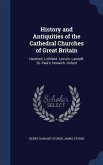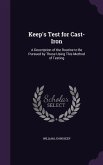The Oxford Handbook of the European Iron Age
Herausgeber: Haselgrove, Colin; Wells, Peter S; Rebay-Salisbury, Katharina
The Oxford Handbook of the European Iron Age
Herausgeber: Haselgrove, Colin; Wells, Peter S; Rebay-Salisbury, Katharina
- Gebundenes Buch
- Merkliste
- Auf die Merkliste
- Bewerten Bewerten
- Teilen
- Produkt teilen
- Produkterinnerung
- Produkterinnerung
The Oxford Handbook of the European Iron Age presents to students, scholars, and interested general readers a broad overview of current understanding of the archaeology of Europe from 1000 BC through to the early historic periods.
Andere Kunden interessierten sich auch für
![The History and Antiquities of the Cathedral Church of Oxford The History and Antiquities of the Cathedral Church of Oxford]() John BrittonThe History and Antiquities of the Cathedral Church of Oxford31,99 €
John BrittonThe History and Antiquities of the Cathedral Church of Oxford31,99 €![Strength and Determination of the Dimensions of Structures of Iron and Steel Strength and Determination of the Dimensions of Structures of Iron and Steel]() Jakob Johann WeyrauchStrength and Determination of the Dimensions of Structures of Iron and Steel35,99 €
Jakob Johann WeyrauchStrength and Determination of the Dimensions of Structures of Iron and Steel35,99 €![Scandinavian Architecture: Buildings and Society in Denmark, Finland, Norway, and Sweden From the Iron Age Until Today Scandinavian Architecture: Buildings and Society in Denmark, Finland, Norway, and Sweden From the Iron Age Until Today]() Thomas PaulssonScandinavian Architecture: Buildings and Society in Denmark, Finland, Norway, and Sweden From the Iron Age Until Today39,99 €
Thomas PaulssonScandinavian Architecture: Buildings and Society in Denmark, Finland, Norway, and Sweden From the Iron Age Until Today39,99 €![A Treatise on the Strength, Flexure, and Stiffness of Cast Iron Beams and Columns A Treatise on the Strength, Flexure, and Stiffness of Cast Iron Beams and Columns]() William TurnbullA Treatise on the Strength, Flexure, and Stiffness of Cast Iron Beams and Columns35,99 €
William TurnbullA Treatise on the Strength, Flexure, and Stiffness of Cast Iron Beams and Columns35,99 €![Ornamental Iron & Bronze Executed By The Winslow Bros. Company, Chicago Ornamental Iron & Bronze Executed By The Winslow Bros. Company, Chicago]() Ornamental Iron & Bronze Executed By The Winslow Bros. Company, Chicago35,99 €
Ornamental Iron & Bronze Executed By The Winslow Bros. Company, Chicago35,99 €![History and Antiquities of the Cathedral Churches of Great Britain: Hereford. Lichfield. Lincoln. Landaff. St. Paul's. Norwich. Oxford History and Antiquities of the Cathedral Churches of Great Britain: Hereford. Lichfield. Lincoln. Landaff. St. Paul's. Norwich. Oxford]() Henry Sargant StorerHistory and Antiquities of the Cathedral Churches of Great Britain: Hereford. Lichfield. Lincoln. Landaff. St. Paul's. Norwich. Oxford40,99 €
Henry Sargant StorerHistory and Antiquities of the Cathedral Churches of Great Britain: Hereford. Lichfield. Lincoln. Landaff. St. Paul's. Norwich. Oxford40,99 €![Keep's Test for Cast-Iron Keep's Test for Cast-Iron]() William John KeepKeep's Test for Cast-Iron28,99 €
William John KeepKeep's Test for Cast-Iron28,99 €-
-
-
The Oxford Handbook of the European Iron Age presents to students, scholars, and interested general readers a broad overview of current understanding of the archaeology of Europe from 1000 BC through to the early historic periods.
Produktdetails
- Produktdetails
- Verlag: Oxford University Press, USA
- Seitenzahl: 1424
- Erscheinungstermin: 27. Dezember 2023
- Englisch
- Abmessung: 249mm x 179mm x 57mm
- Gewicht: 2286g
- ISBN-13: 9780199696826
- ISBN-10: 0199696829
- Artikelnr.: 68210981
- Verlag: Oxford University Press, USA
- Seitenzahl: 1424
- Erscheinungstermin: 27. Dezember 2023
- Englisch
- Abmessung: 249mm x 179mm x 57mm
- Gewicht: 2286g
- ISBN-13: 9780199696826
- ISBN-10: 0199696829
- Artikelnr.: 68210981
Colin Haselgrove is Emeritus Professor of Archaeology at the University of Leicester. He lectured at Durham University from 1977-2004 and was Professor at Leicester University from 2005 until he retired in 2021. His main interests are in Iron Age studies, settlement landscapes, early coinage, and Roman impact on indigenous societies. He has conducted fieldwork in France, England and Scotland. He is currently working on developing chronologies for Iron Age sites in Wessex, on rural settlement in northern France in the first millennia BC and AD, and on south-east Britain at the time of Julius Caesar's invasions. He is a Fellow of the British Academy. Katharina Rebay-Salisbury is an archaeologist with a research focus on the European Bronze and Iron Ages. After completing her PhD in 2005, she was a post-doctoral researcher at the Universities of Cambridge and Leicester in the UK, where she participated in research programmes on the human body and networks. In 2015, she was awarded the ERC Starting Grant for her project 'The value of mothers to society: responses to motherhood and child rearing practices in prehistoric Europe'. She directs the research group 'Prehistoric Identities' at the Austrian Archaeological Institute of the Academy of Sciences and teaches at the University of Vienna. Peter S. Wells is Professor of Anthropology at the University of Minnesota. He has directed excavations at three settlement sites in southern Germany, recovering materials ranging in time from the Early Bronze Age through the Late Iron Age. His principal interests include interactions between communities, art and visuality, and ritual practices. His recent works include The Battle that Stopped Rome (2003) and Beyond Celts, Germans, and Scythians (2001).
* I: INTRODUCTION
* 1: Colin Haselgrove, Katharina Rebay-Salisbury, and Peter S. Wells:
Introduction: the Iron Age in Europe
* 2: Colin Haselgrove, Katharina Rebay-Salisbury, and Peter S. Wells:
Europe in the Iron Age: landscapes, regions, climate, and people
* 3: Colin Haselgrove, Katharina Rebay-Salisbury, and Peter S. Wells:
Chronology in Iron Age Europe: current approaches and challenges
* II: REGIONAL SYNTHESES
* 4: Colin Haselgrove and Sophie Krausz: The British Isles and the near
Continent
* 5: Frands Herschend: Scandinavia and northern Germany
* 6: Valter Lang: The eastern Baltic
* 7: Wojciech Nowakowski: Eastern central Europe: between the Elbe and
the Dnieper
* 8: Carola Metzner-Nebelsick: Central Europe
* 9: Dominique Garcia: Southern France
* 10: Xosé-Lois Armada and Ignacio Grau Mira: The Iberian Peninsula
* 11: Raffaele de Marinis and Biba Terzan: The northern Adriatic
* 12: Lin Foxhall: The central Mediterranean and the Aegean
* 13: Stefanos Gimatzidis: Northern Greece and the central
* 14: Aurel Rustoiu: The Carpathian and Danubian area
* 15: Sabine Reinhold and Valentina Mordvintseva: The northern Black
Sea and north Caucasus
* 16: Ludmila Koryakova: Europe to Asia
* 17: Naoise Mac Sweeney and Peter S. Wells: Edges and interactions
beyond Europe
* III: THEMES IN IRON AGE ARCHAEOLOGY
* 18: Hansjörg Küster: Food, foodways, and subsistence
* 19: Maaike Groot: Animals and animal husbandry
* 20: Leo Webley: Households and communities
* 21: Stephan Fichtl: Urbanization and oppida
* 22: Holger Wendling and Manfred K. H. Eggert: Building landscapes and
monuments
* 23: Timothy Champion: Iron and iron technology
* 24: Rupert Gebhard: Raw materials, technology, and innovation
* 25: Fraser Hunter: Material worlds
* 26: Johanna Banck-Burgess: Textiles and clothing
* 27: Chris Gosden: Trade and exchange
* 28: Colin Haselgrove: Coinage and coin use
* 29: John Collis and Raimund Karl: Politics and power
* 30: Simon James: Warriors, war, and weapons; or arms, the armed, and
armed violence
* 31: Tom Moore: Wealth, status, and occupation groups
* 32: Katharina Rebay-Salisbury: Horses, wagons, and chariots
* 33: Michael Gebühr and Stefan Burmeister: Demographic aspects of Iron
Age societies
* 34: Rachel Pope: Gender and society
* 35: T. L. Thurston: Regions, groups, and identity: an intellectual
history
* 36: Daphne Nash Briggs: Writing, writers, and Iron Age Europe
* 37: Andrew Fitzpatrick: Migration
* 38: Adam Rogers: Indigenous communities under Rome
* 39: Jody Joy: Feasting and commensal rituals
* 40: Patrice Brun: Funerary practices
* 41: Ian Armit: Ritual sites, offerings, and sacrifice
* 42: Miranda Aldhouse-Green: Formal religion
* 43: Martin Guggisberg: Art on the northern edge of the Mediterranean
world
* 1: Colin Haselgrove, Katharina Rebay-Salisbury, and Peter S. Wells:
Introduction: the Iron Age in Europe
* 2: Colin Haselgrove, Katharina Rebay-Salisbury, and Peter S. Wells:
Europe in the Iron Age: landscapes, regions, climate, and people
* 3: Colin Haselgrove, Katharina Rebay-Salisbury, and Peter S. Wells:
Chronology in Iron Age Europe: current approaches and challenges
* II: REGIONAL SYNTHESES
* 4: Colin Haselgrove and Sophie Krausz: The British Isles and the near
Continent
* 5: Frands Herschend: Scandinavia and northern Germany
* 6: Valter Lang: The eastern Baltic
* 7: Wojciech Nowakowski: Eastern central Europe: between the Elbe and
the Dnieper
* 8: Carola Metzner-Nebelsick: Central Europe
* 9: Dominique Garcia: Southern France
* 10: Xosé-Lois Armada and Ignacio Grau Mira: The Iberian Peninsula
* 11: Raffaele de Marinis and Biba Terzan: The northern Adriatic
* 12: Lin Foxhall: The central Mediterranean and the Aegean
* 13: Stefanos Gimatzidis: Northern Greece and the central
* 14: Aurel Rustoiu: The Carpathian and Danubian area
* 15: Sabine Reinhold and Valentina Mordvintseva: The northern Black
Sea and north Caucasus
* 16: Ludmila Koryakova: Europe to Asia
* 17: Naoise Mac Sweeney and Peter S. Wells: Edges and interactions
beyond Europe
* III: THEMES IN IRON AGE ARCHAEOLOGY
* 18: Hansjörg Küster: Food, foodways, and subsistence
* 19: Maaike Groot: Animals and animal husbandry
* 20: Leo Webley: Households and communities
* 21: Stephan Fichtl: Urbanization and oppida
* 22: Holger Wendling and Manfred K. H. Eggert: Building landscapes and
monuments
* 23: Timothy Champion: Iron and iron technology
* 24: Rupert Gebhard: Raw materials, technology, and innovation
* 25: Fraser Hunter: Material worlds
* 26: Johanna Banck-Burgess: Textiles and clothing
* 27: Chris Gosden: Trade and exchange
* 28: Colin Haselgrove: Coinage and coin use
* 29: John Collis and Raimund Karl: Politics and power
* 30: Simon James: Warriors, war, and weapons; or arms, the armed, and
armed violence
* 31: Tom Moore: Wealth, status, and occupation groups
* 32: Katharina Rebay-Salisbury: Horses, wagons, and chariots
* 33: Michael Gebühr and Stefan Burmeister: Demographic aspects of Iron
Age societies
* 34: Rachel Pope: Gender and society
* 35: T. L. Thurston: Regions, groups, and identity: an intellectual
history
* 36: Daphne Nash Briggs: Writing, writers, and Iron Age Europe
* 37: Andrew Fitzpatrick: Migration
* 38: Adam Rogers: Indigenous communities under Rome
* 39: Jody Joy: Feasting and commensal rituals
* 40: Patrice Brun: Funerary practices
* 41: Ian Armit: Ritual sites, offerings, and sacrifice
* 42: Miranda Aldhouse-Green: Formal religion
* 43: Martin Guggisberg: Art on the northern edge of the Mediterranean
world
* I: INTRODUCTION
* 1: Colin Haselgrove, Katharina Rebay-Salisbury, and Peter S. Wells:
Introduction: the Iron Age in Europe
* 2: Colin Haselgrove, Katharina Rebay-Salisbury, and Peter S. Wells:
Europe in the Iron Age: landscapes, regions, climate, and people
* 3: Colin Haselgrove, Katharina Rebay-Salisbury, and Peter S. Wells:
Chronology in Iron Age Europe: current approaches and challenges
* II: REGIONAL SYNTHESES
* 4: Colin Haselgrove and Sophie Krausz: The British Isles and the near
Continent
* 5: Frands Herschend: Scandinavia and northern Germany
* 6: Valter Lang: The eastern Baltic
* 7: Wojciech Nowakowski: Eastern central Europe: between the Elbe and
the Dnieper
* 8: Carola Metzner-Nebelsick: Central Europe
* 9: Dominique Garcia: Southern France
* 10: Xosé-Lois Armada and Ignacio Grau Mira: The Iberian Peninsula
* 11: Raffaele de Marinis and Biba Terzan: The northern Adriatic
* 12: Lin Foxhall: The central Mediterranean and the Aegean
* 13: Stefanos Gimatzidis: Northern Greece and the central
* 14: Aurel Rustoiu: The Carpathian and Danubian area
* 15: Sabine Reinhold and Valentina Mordvintseva: The northern Black
Sea and north Caucasus
* 16: Ludmila Koryakova: Europe to Asia
* 17: Naoise Mac Sweeney and Peter S. Wells: Edges and interactions
beyond Europe
* III: THEMES IN IRON AGE ARCHAEOLOGY
* 18: Hansjörg Küster: Food, foodways, and subsistence
* 19: Maaike Groot: Animals and animal husbandry
* 20: Leo Webley: Households and communities
* 21: Stephan Fichtl: Urbanization and oppida
* 22: Holger Wendling and Manfred K. H. Eggert: Building landscapes and
monuments
* 23: Timothy Champion: Iron and iron technology
* 24: Rupert Gebhard: Raw materials, technology, and innovation
* 25: Fraser Hunter: Material worlds
* 26: Johanna Banck-Burgess: Textiles and clothing
* 27: Chris Gosden: Trade and exchange
* 28: Colin Haselgrove: Coinage and coin use
* 29: John Collis and Raimund Karl: Politics and power
* 30: Simon James: Warriors, war, and weapons; or arms, the armed, and
armed violence
* 31: Tom Moore: Wealth, status, and occupation groups
* 32: Katharina Rebay-Salisbury: Horses, wagons, and chariots
* 33: Michael Gebühr and Stefan Burmeister: Demographic aspects of Iron
Age societies
* 34: Rachel Pope: Gender and society
* 35: T. L. Thurston: Regions, groups, and identity: an intellectual
history
* 36: Daphne Nash Briggs: Writing, writers, and Iron Age Europe
* 37: Andrew Fitzpatrick: Migration
* 38: Adam Rogers: Indigenous communities under Rome
* 39: Jody Joy: Feasting and commensal rituals
* 40: Patrice Brun: Funerary practices
* 41: Ian Armit: Ritual sites, offerings, and sacrifice
* 42: Miranda Aldhouse-Green: Formal religion
* 43: Martin Guggisberg: Art on the northern edge of the Mediterranean
world
* 1: Colin Haselgrove, Katharina Rebay-Salisbury, and Peter S. Wells:
Introduction: the Iron Age in Europe
* 2: Colin Haselgrove, Katharina Rebay-Salisbury, and Peter S. Wells:
Europe in the Iron Age: landscapes, regions, climate, and people
* 3: Colin Haselgrove, Katharina Rebay-Salisbury, and Peter S. Wells:
Chronology in Iron Age Europe: current approaches and challenges
* II: REGIONAL SYNTHESES
* 4: Colin Haselgrove and Sophie Krausz: The British Isles and the near
Continent
* 5: Frands Herschend: Scandinavia and northern Germany
* 6: Valter Lang: The eastern Baltic
* 7: Wojciech Nowakowski: Eastern central Europe: between the Elbe and
the Dnieper
* 8: Carola Metzner-Nebelsick: Central Europe
* 9: Dominique Garcia: Southern France
* 10: Xosé-Lois Armada and Ignacio Grau Mira: The Iberian Peninsula
* 11: Raffaele de Marinis and Biba Terzan: The northern Adriatic
* 12: Lin Foxhall: The central Mediterranean and the Aegean
* 13: Stefanos Gimatzidis: Northern Greece and the central
* 14: Aurel Rustoiu: The Carpathian and Danubian area
* 15: Sabine Reinhold and Valentina Mordvintseva: The northern Black
Sea and north Caucasus
* 16: Ludmila Koryakova: Europe to Asia
* 17: Naoise Mac Sweeney and Peter S. Wells: Edges and interactions
beyond Europe
* III: THEMES IN IRON AGE ARCHAEOLOGY
* 18: Hansjörg Küster: Food, foodways, and subsistence
* 19: Maaike Groot: Animals and animal husbandry
* 20: Leo Webley: Households and communities
* 21: Stephan Fichtl: Urbanization and oppida
* 22: Holger Wendling and Manfred K. H. Eggert: Building landscapes and
monuments
* 23: Timothy Champion: Iron and iron technology
* 24: Rupert Gebhard: Raw materials, technology, and innovation
* 25: Fraser Hunter: Material worlds
* 26: Johanna Banck-Burgess: Textiles and clothing
* 27: Chris Gosden: Trade and exchange
* 28: Colin Haselgrove: Coinage and coin use
* 29: John Collis and Raimund Karl: Politics and power
* 30: Simon James: Warriors, war, and weapons; or arms, the armed, and
armed violence
* 31: Tom Moore: Wealth, status, and occupation groups
* 32: Katharina Rebay-Salisbury: Horses, wagons, and chariots
* 33: Michael Gebühr and Stefan Burmeister: Demographic aspects of Iron
Age societies
* 34: Rachel Pope: Gender and society
* 35: T. L. Thurston: Regions, groups, and identity: an intellectual
history
* 36: Daphne Nash Briggs: Writing, writers, and Iron Age Europe
* 37: Andrew Fitzpatrick: Migration
* 38: Adam Rogers: Indigenous communities under Rome
* 39: Jody Joy: Feasting and commensal rituals
* 40: Patrice Brun: Funerary practices
* 41: Ian Armit: Ritual sites, offerings, and sacrifice
* 42: Miranda Aldhouse-Green: Formal religion
* 43: Martin Guggisberg: Art on the northern edge of the Mediterranean
world








